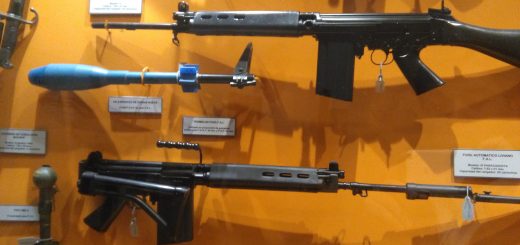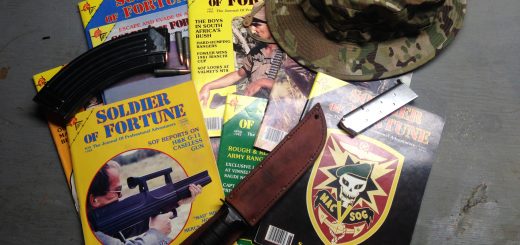Japanese Hobbyist Reenactments of Historical Wars
November 10, 2020 – The day is cold, frosty, and muddy. The squad leader halts the group, and motions myself, the marksman, and another rifleman to look beyond the hill into the small valley below. Ahead, at some distance, there was a formation of French United Nations peacekeepers and Bosnia militiamen at a standoff with each other in a tense moment. The marksman begins to fire at the United Nations forces with his scoped hunting rifle and is then followed by a few single well-aimed shots from the other two of our fireteam. The other rifleman shoots one of the Bosnian militiamen, while I was able to hit one of the United Nations soldiers with a center-mass shot with my vintage M16 assault rifle, both of them collapse. In chaos and confusion, with a bunch of screaming in French, English, and Japanese the United Nation soldiers engage the Bosnian militia, unbeknownst to both sides that it was us, the Croatian HVO that initiated the ambush.
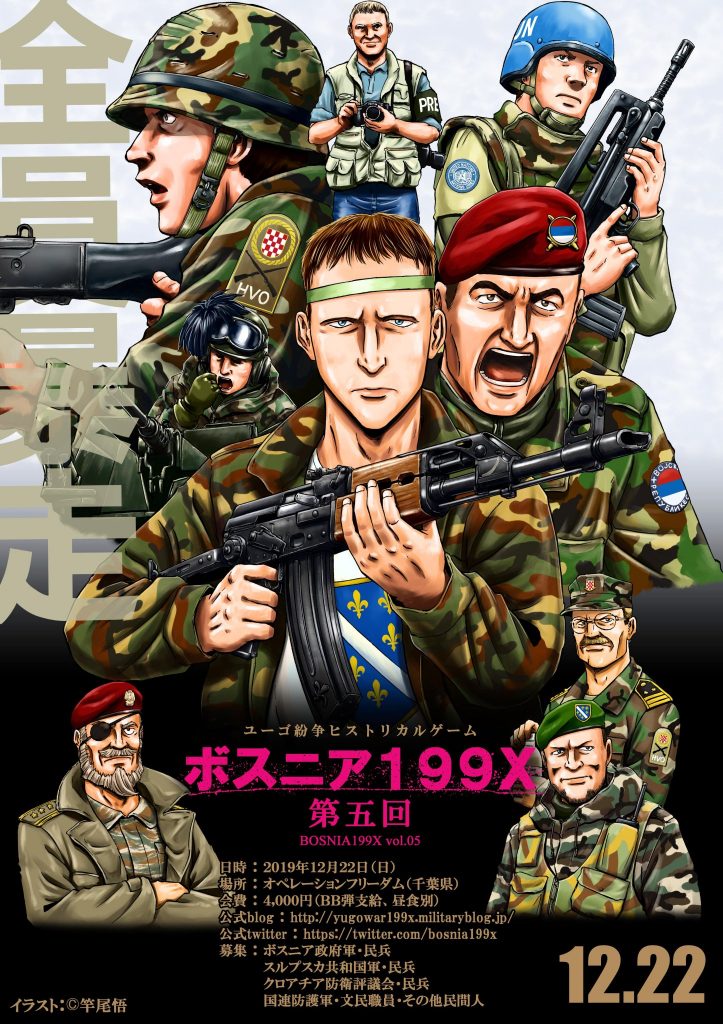
We regroup, observing the chaos, and in a moment of complacency our squad gets ambushed as well. An enemy element composed of the Yugoslav People’s Army spots us and starts to open fire. I duck behind cover while the squad scrambles to find their own. One of our riflemen jumps and slides into a gully and sprains her ankle. I emerge from my cover as well as the rest of our squad with our rifles slung and our hands up and waving, shouting at the “enemy” to wait and to stop, in Japanese. Plastic BBs bounce from our bodies while the enemy looks at us in confusion. Referees wearing bright yellow vests emerge, blowing whistles and air horns, running into the middle while everybody halts the reenactment. The injured woman who was reenacting one of the Croat soldiers is carried out of the field in a stretcher while the participants try and figure out what to do next. Such is life in reenacting the Bosnian War, set in the early 1990s at one of the many Japanese airsoft fields that host these types of events.
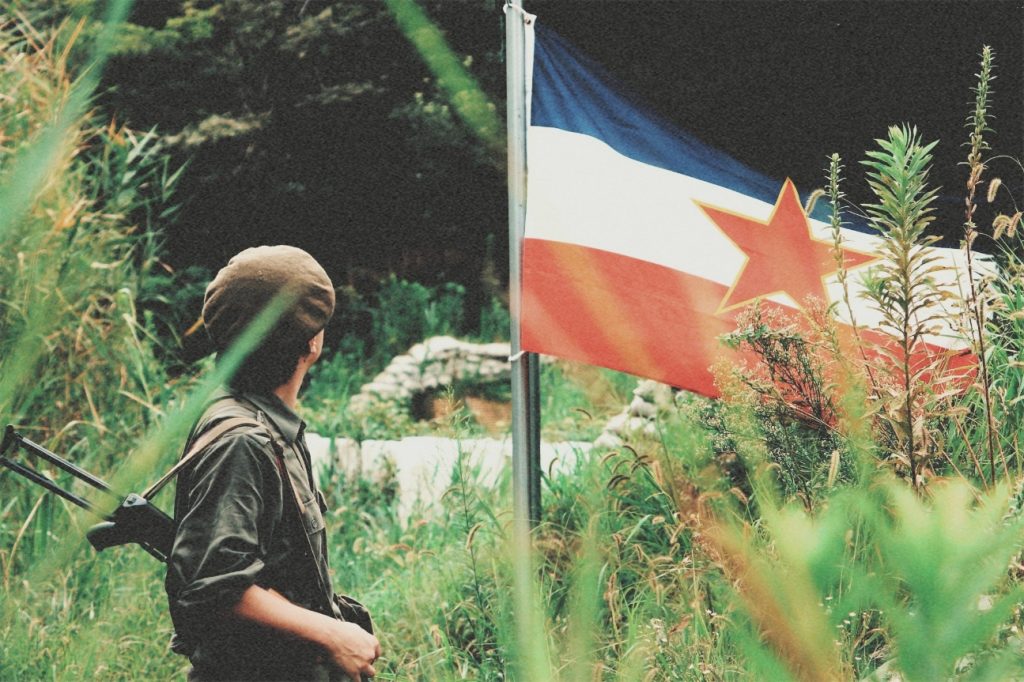
Reenactor portraying a soldier in the Yugoslav People’s Army (JNA)
“Sabage”, or “airsoft” as it is colloquially referred to in English speaking countries, is a hobby that originated in Japan. Airsoft guns are of course modeled after real firearms, but instead fire plastic BBs using compressed air, and is facilitated by batteries, compressed gas, or manually cocked spring pressure. Eye protection must be worn when handling airsoft guns and it is highly recommended to wear thick clothing and face coverings. However, airsoft guns in Japan are limited to velocities that would not be considered dangerous (under 1 joule). One of the first (and most popular) airsoft manufacturers in the world, Tokyo Marui, originated in Japan in the 1980s and invented battery powered guns in the 1990s, with its designs still being imitated and produced today.
Early Promotion of the Tokyo Marui M16 Airsoft Rifle (1991)
In these historical reenactments, attention to detail is paramount, and replicas of specific firearms or equipment issued at the time of these historical events are to be used. Anachronism, or FARB is something to be avoided, as not to detract from the historical accuracy of the historical events portrayed. In the historical reenactment of the Yugoslav Wars, Bosnia199X is hosted annually in Chiba, Japan. There are specific guidelines as to what sort of equipment, outfits, and replica firearms are to be used, and to each specific faction in the reenactment. The setting of the event is in the early 1990s, in which reenactors of the United States Army or NATO IFOR are not present. Reenactors of French United Nations peacekeepers wear French camouflage fatigues, French load bearing equipment and don light blue UN helmets, berets, brassards, and wield replicas of the FAMAS rifle. For reenactors who portray soldiers of the Yugoslav People’s Army, they would use the same uniforms and equipment, and ideally outfit themselves with a specific replica of the Yugoslav-made variant of the AKM rifle. Although a generic wood-stocked AK is also acceptable. Paramilitary reenactors can be less strict and are able to wear, for example, an old Adidas tracksuit, plain trousers, and wield a basic Kalashnikov rifle. However, weapons from the future with optics and rail attachments, in addition to modern military fatigues with Velcro and digital camouflage are not allowed.
There is a large and diverse amount of Japanese war reenactors and a broad range of Japanese people who are interested in the hobby. The historical conflicts reenacted are also expansive into such conflicts as the Central and Southern African Bush Wars, the Yugoslav Wars, the Vietnam War (The Second Indochina War), the Soviet-Afghan War, the Second World War, and the Sino-Vietnam War. Factions depicted and reenacted are also varied. Of these examples include the United States Marine Corps, Japanese Self Defense Force, Afghan Mujahideen, North Vietnamese Vietcong, the Waffen SS, the Chinese People’s Liberation Army, and the Serb Arkan Tigers. Most of the uniforms and military equipment used by these reenactors are reproductions, often fabricated in China. The more dedicated hobbyists often use genuine military surplus equipment and uniforms, but these are sometimes rare, expensive, and have limited availability.
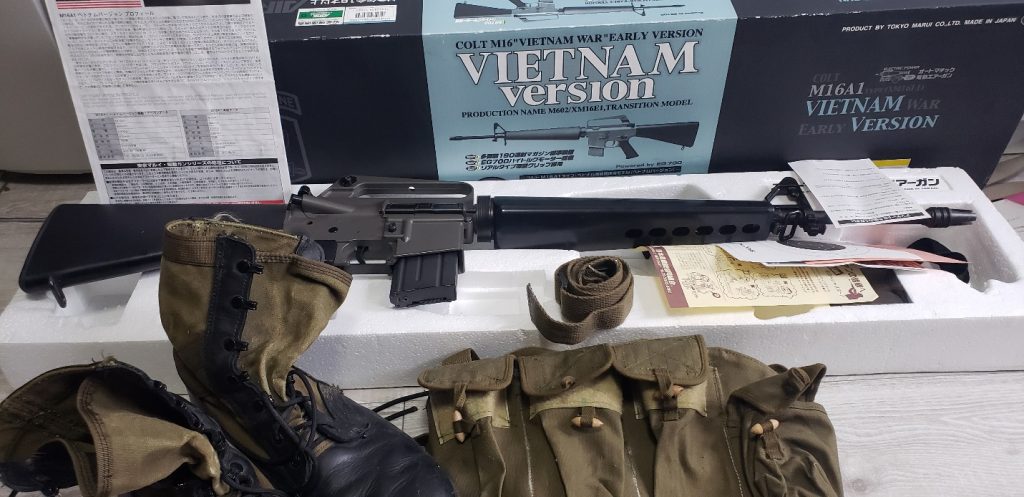
Vintage Tokyo Marui M16A1 Airsoft Rifle alongside genuine Chinese & American military surplus for use in Cold War reenactments
“Playing airsoft gives me an adrenaline rush, and it’s preparation for combat drills and training in the future when I join the JSDF”, says Akagi Tato, a university student at Meiji University who participates in airsoft and military reenactments as a hobby. He works as an airsoft gun salesman at AIRSOFT97, an airsoft gun hobby shop located north of Akihabara in Taito, Tokyo Japan. Mr. Tato primarily reenacts as an infantryman of the Japan Self Defense Forces (JSDF). Individuals have different reasons or interests as to why they choose to reenact certain military factions. For Mr. Tato, he has a fondness for the JSDF, as he grew up as a military “brat” with family members in the JSDF. He also has an interest in historical Japanese military units, such as the Meiji Imperial Army of Japan. Mr. Tato says that while playing airsoft is relatively inexpensive, the reenactments have a rather costly barrier of entry. “Some military reenactors have a desire to join the JSDF, while many more reenactors are veterans who had joined the JSDF” is an observation by Mr. Tato on the kinds of people who specifically do military reenactment as a hobby. Mr. Tato also notes that fictional events are also reenacted, such as the post-apocalyptic setting of the movie Mad Max.
There is interest in certain replica guns that are sold, but the majority of guns are replicas of the United States M4 Carbine. Airsoft M4 carbines are popular because of the widespread availability, popular depiction in media, perceived prestige by use from American and special forces groups, good value, excellent availability for aftermarket modifications, as well as its good ergonomics overall. Most airsoft guns hobbyists purchase are typically made in Japan or Taiwan, or manufacturers that have a high reputation for their build quality. “Reenactors would opt for specific models if available“, Mr. Tato observes, for example that Taiwan T91 carbine airsoft replicas are purchased by Republic of China Army and special forces reenactors. Popular media such as anime, video games, and movies also create interest for military reenactment and in some cases spark a desire to join the military. “When the movie John Wick came out, popular models of airsoft guns that John Wick uses, such as the Taran Tactical M4, became really popular.” Says Mr. Tato. “The anime GATE is a recruiting tool for the JSDF and has also created interest for JSDF reenactors. The anime Girls und Panzer boosted recruit numbers for the JSDF tank corps”.
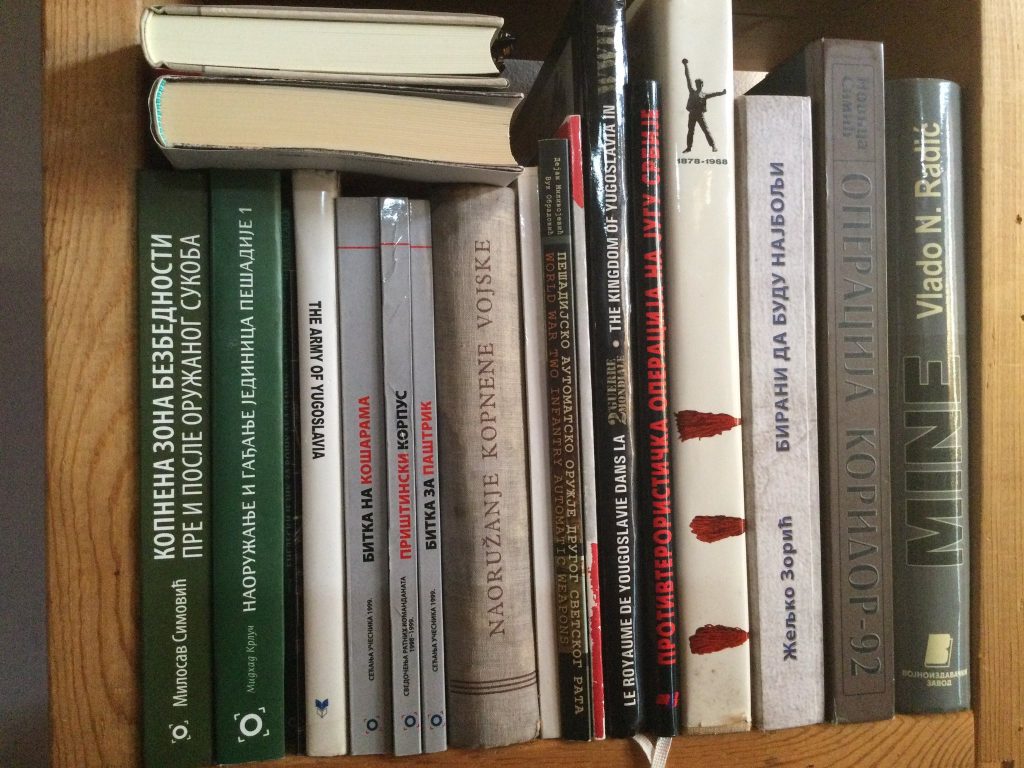
A section of books on the military of Yugoslavia in Daichi Hayshi’s collection
Daichi Hayshi is a military reenactor revolving around late 20th century Yugoslavia and the Balkans. His hobbies are airsoft, military reenactment, and collecting historical books and militaria from the Balkans. There are several challenges Mr. Hayshi has faced regarding reenactment of Yugoslav military units, such as the Yugoslav People’s Army. Mr. Hayshi says that “Lack of military experience needs more effort to understand what to do. For example, when I read infantry manual of Yugoslav People’s Army, a double-translation or even triple-translation is needed practically.” He then further explains in detail complications in understanding JNA military procedures and doctrine, even with original infantry field manuals in hand. He has to translate from Serb-Croat, to English, and then sometimes to Japanese in regards to specific military terms. Regarding specific military factions or units that are portrayed, Mr. Hayshi reenacts as the Bosnian Serb Army, JNA, and other Serb militia groups.
Johnny Phaxay is an airsoft salesman and technician who also works in AIRSOFT97. He does not participate in historical reenactments, but in his observations as a salesman he sees that “While most airsoft players often choose G&G M4 carbines to play with, reenactors would choose to get specific types of guns. Vietnam War reenactors would choose vintage M16s with specific attention to detail.” In the hobby of airsoft, Mr. Phaxay says that “The only unpopular guns are made from brands of poor quality. Cheap Chinese-made airsoft guns that are only popular with novices”. Mr. Phaxay observes that specific models from certain anime, video games, and movies become popular if released. Some examples of which are the pink P90 submachine gun from the anime Gun Gale Online, handguns from the video game Resident Evil, and rifles and pistols from the movie John Wick. In his own observations at airsoft games, while most players generally play skirmishes, for those that reenact more often there are reenactments of special forces units.
There is a deep appreciation for military reenactment in Japan. With the hobby of airsoft originating and becoming popular in Japan alongside the large and diverse availability of replica guns and gear to purchase, there is a sizable number of reenactors. Interest is expected to grow in the future, especially as more popular media such as video games, anime, or movies continue to be made. If information becomes more accessible to the Japanese, such as localization of books and other international media, there is massive potential for the increase in hobbyists who discover it.
